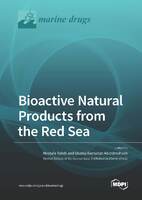Dublin Core
Title
Bioactive Natural Products from the Red Sea
Subject
Marine, Sea, Science, Drugs
Description
The marine environment has proven to be a rich source of diverse natural products
with relevant activities such as anticancer, anti-inflammatory, antiepileptic, immunomodulatory,
antifungal, antiviral, and antiparasitic [1,2]. The global marine pharmaceutical
clinical pipeline comprises of 48 compounds originating from different marine invertebrates
and marine microorganisms, including 15 approved drugs by the most representative approving
agencies, 5 drug candidates in phase III, 12 in phase II, and 16 in phase I of drug
development clinical phases [3]. Marine invertebrates and associated microorganisms are
capable of synthesizing diverse classes of secondary metabolites and, in some cases, novel
chemical leads of which terrestrial counterparts have never been discovered.
The Red Sea is the world’s northernmost tropical sea, acting as an inlet of the Indian
Ocean, lying between Africa and Asia. It has a surface area of roughly 450,000 km2 and is
approximately 2250 km long, with a maximum depth of around 3000 m. The Red Sea is
approximately 5% greater than the world average salinity, due to a high rate of evaporation
and a lack of significant rivers or streams draining into it [4]. The Red Sea is a rich and
diverse ecosystem due to the 2000 km of coral reef extending along its coastline. It is
inhabited by over 1000 invertebrate species and 200 soft and hard corals [5]. Due to this
high biodiversity and limited research, the Red Sea is a promising, underexplored habitat
for the discovery of new bioactive marine natural products.
This Special Issue contains nine articles, including eight research articles on different
topics related to the natural products derived from the Red Sea and one review article. In
the following sections, we would provide a short overview of what the reader will find in
our Special Issue.
Qader et al. reported the isolation and identification of a new cyclic tripeptide named
epicotripeptin, along with four known cyclic dipeptides and one acetamide, derivative
from seagrass-associated endophytic fungus Epicoccum nigrum M13 recovered from the
Red Sea. Moreover, they reported two new compounds, cyclodidepsipeptide phragamide
A and trioxobutanamide derivative phragamide B, together with eight known compounds
from plant-derived endophyte Alternaria alternata 13A collected from a saline lake of the
Wadi El Natrun depression in the Sahara Desert. The antimicrobial screening indicated
that seven of the tested compounds exhibited considerable (MIC range of 2.5–5 μg/mL)
to moderate (10–20 μg/mL) antibacterial effect against the tested Gram-positive strains,
and moderate to weak (10–30 μg/mL) antibacterial effect against Gram-negative strains.
On the other hand, four of the tested compounds showed considerable antibiofilm effects
against biofilm-forming Gram-positive and Gram-negative strains [6].
with relevant activities such as anticancer, anti-inflammatory, antiepileptic, immunomodulatory,
antifungal, antiviral, and antiparasitic [1,2]. The global marine pharmaceutical
clinical pipeline comprises of 48 compounds originating from different marine invertebrates
and marine microorganisms, including 15 approved drugs by the most representative approving
agencies, 5 drug candidates in phase III, 12 in phase II, and 16 in phase I of drug
development clinical phases [3]. Marine invertebrates and associated microorganisms are
capable of synthesizing diverse classes of secondary metabolites and, in some cases, novel
chemical leads of which terrestrial counterparts have never been discovered.
The Red Sea is the world’s northernmost tropical sea, acting as an inlet of the Indian
Ocean, lying between Africa and Asia. It has a surface area of roughly 450,000 km2 and is
approximately 2250 km long, with a maximum depth of around 3000 m. The Red Sea is
approximately 5% greater than the world average salinity, due to a high rate of evaporation
and a lack of significant rivers or streams draining into it [4]. The Red Sea is a rich and
diverse ecosystem due to the 2000 km of coral reef extending along its coastline. It is
inhabited by over 1000 invertebrate species and 200 soft and hard corals [5]. Due to this
high biodiversity and limited research, the Red Sea is a promising, underexplored habitat
for the discovery of new bioactive marine natural products.
This Special Issue contains nine articles, including eight research articles on different
topics related to the natural products derived from the Red Sea and one review article. In
the following sections, we would provide a short overview of what the reader will find in
our Special Issue.
Qader et al. reported the isolation and identification of a new cyclic tripeptide named
epicotripeptin, along with four known cyclic dipeptides and one acetamide, derivative
from seagrass-associated endophytic fungus Epicoccum nigrum M13 recovered from the
Red Sea. Moreover, they reported two new compounds, cyclodidepsipeptide phragamide
A and trioxobutanamide derivative phragamide B, together with eight known compounds
from plant-derived endophyte Alternaria alternata 13A collected from a saline lake of the
Wadi El Natrun depression in the Sahara Desert. The antimicrobial screening indicated
that seven of the tested compounds exhibited considerable (MIC range of 2.5–5 μg/mL)
to moderate (10–20 μg/mL) antibacterial effect against the tested Gram-positive strains,
and moderate to weak (10–30 μg/mL) antibacterial effect against Gram-negative strains.
On the other hand, four of the tested compounds showed considerable antibiofilm effects
against biofilm-forming Gram-positive and Gram-negative strains [6].
Creator
Editors :
Mostafa Rateb
Usama Ramadan Abdelmohsen
Mostafa Rateb
Usama Ramadan Abdelmohsen
Source
https://www.mdpi.com/books
Publisher
MDPI
Date
2021
Contributor
Jadik Wijayanto
Rights
https://doi.org/10.3390/books978-3-0365-1587-8
Relation
https://www.mdpi.com/books/book/4235-bioactive-natural-products-from-the-red-sea
Format
PDF
Language
English
Type
Textbook
Identifier
ISBN 978-3-0365-1588-5 (Hbk)
ISBN 978-3-0365-1587-8 (PDF)
ISBN 978-3-0365-1587-8 (PDF)
Coverage
Switzerland

